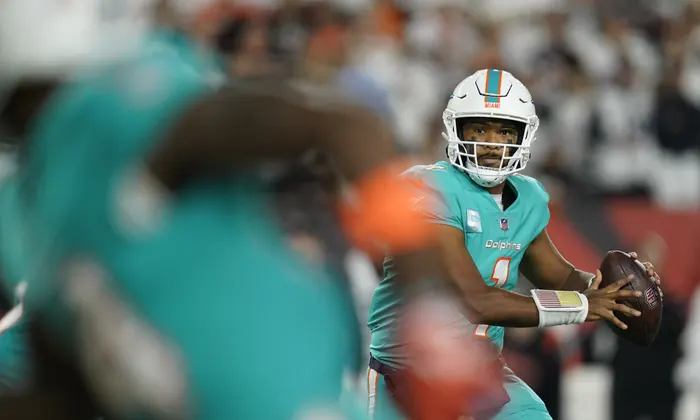The Dolphins let down Tua Tagovailoa. Will it make a difference?
The Dolphins let down Tua Tagovailoa. Will it make a difference? The Cincinnati Bengals and the Miami Dolphins played a football game on Thursday night. A victory for the Bengals.
Tyreek Hill amassed a huge yardage total on receptions. Many memorable events occurred. The question is, though, who notices? The night’s major storyline far outweighs the importance of play calling, blocking, and statistics.
Tua Tagovailoa, the quarterback for the Dolphins, had to be carried off the field after being sacked by Bengals defensive tackle Josh Tupou in the second quarter.
Tagovailoa was rushed to the emergency room of a local facility. It was a nightmare of a situation.
The Dolphins quickly diagnosed a head and neck injury. Concussion, or traumatic brain damage, is the correct term, nonetheless. Replays indicated that Tagovailoa’s fingers sprayed as though he was trying to bend them, as if the force of the strike and the immobility of his body weren’t enough.
Posturing is a frightening phenomenon since it is so strange. It’s one of the clearest indicators of a head injury.
Statements
“His fingers remain tight like that because of this constant electrical signals being given to those muscles due to that head trauma,” sports medicine doctor Brian Sutterer revealed.
Tagovailoa should not have been on the active roster, adding to the frustration and sadness felt after his concussion on Thursday night.
Tagovailoa took a similar hit against Buffalo just four days ago. This time, his head smacked the ground. He stood up this time, but not without some stumbling, wobbling, and shaking his head, possibly to get “the cobwebs” out.
Despite Tagovailoa not touching his back, the Dolphins call this a reaggravated back injury. Even though he had been given the all-clear by the Dolphins’ club doctors and an “outside neurologist,” he mysteriously returned to the game.
NFL
Critics of the NFL’s concussion protocol are worried about Tagovailoa playing on Thursday as the short NFL week suddenly raced by. Before Thursday’s game, Harvard-educated neuroscientist Chris Nowinski posted a grim prediction.
He warned that if Tua played tonight, it would be a major setback for NFL concussion protocols. If he suffers another concussion that ends his season or career, his coaches and the league should be held legally responsible. Everybody witnessed it; surely they could see this is wrong.
Then the blow finally arrived. Fingers twisted in strange ways. A stretcher had just come.
The NFLPA has initiated a probe. Potential modifications to the NFL’s concussion protocol are possible. For instance, they may do away with the provision stating that a player cannot play if they are experiencing instability unless that instability can be traced to an orthopedic cause.
In its current form, this language already reveals the priority the league and its teams place on playing every game. Why bring a human with broken bones, torn tendons, or even a possible head injury to the football field in the first place?
MLB
Sad as it may be, the NFL does very little to safeguard the people who make up its brand. In recent years, the NBA has been taking occasional games off to rest its starters and other high-profile players.
Despite the league’s many flaws, MLB has moved toward reducing starting pitchers’ workloads. Analytics suggest that a pitcher’s performance declines after the third time through the batting order, so fewer innings pitched are better for the pitcher’s arm in the long run. However, the NFL has added a 17th game because it feels the need to increase income.
Injuries persist despite a concussion protocol and rules designed to make the game safer, such as “defenseless receivers” and “personal fouls” for hits on quarterbacks. There has been a consistent increase in the number of reported concussions, while the number of ACL and MCL ruptures has risen.
Professional football is entertaining partly because it allows viewers to witness athletes attempting and completing tasks that the human body was not designed to perform.
Each participant must decide for themselves whether or not to take that chance. They considered the possibility of injury when deciding to play football but ultimately decided it was worth it.
Facts
However, no one ever expected the Dolphins to appear to be gambling with the life of their starting quarterback. The helmet prevents a skull fracture, but not brain harm, as former NFL player Emmanuel Acho described it.
The fact that Tagovailoa’s head was banged down twice in four days is at the heart of the widespread fury that began on Thursday night.
It’s hard to wrap one’s head around the fact that we can watch this game without feeling remorse, that medical professionals let this young man play, and that the league doesn’t do more to raise awareness about the risks of brain trauma among its players and spectators.
The unfortunate truth is that most NFL fans wouldn’t have given Tagovailoa’s brain and the likely impact of playing so soon after his “back” injury another attention had he not exited the game on a stretcher.
A former NFL running back named Thomas Jones recently urged team trainers to follow their consciences.
Final words
The league’s bottom line is that its players have only worth when they are on the field, and while not all team medical staffs are as blatantly neglectful as the Dolphins in Tagovailoa, that doesn’t change the league’s bottom line.
After the Dolphins’ loss to the Bengals, head coach Mike McDaniel addressed the media and, in a single phrase, summed up the problem with the NFL’s messaging on head injuries.
The “wonderful news” that his quarterback “doesn’t have anything more serious than a concussion” was shared by McDaniel. A $765 million judgment, cases of chronic traumatic encephalopathy (CTE) in past players, and general ignorance of brain damage make it unthinkable that an NFL head coach would have the chutzpah to discount any injury, especially in Tagovailoa’s case.

